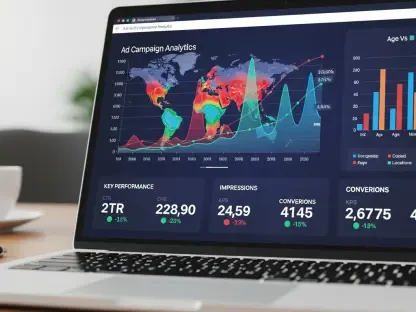The Landscape of Digital Advertising and Meta’s Role
The digital advertising industry stands as a cornerstone of the global economy, generating hundreds of billions in revenue annually by connecting brands with consumers through targeted online campaigns. This sector drives engagement across platforms, shaping how businesses build relationships with their audiences in an increasingly connected world. With user attention becoming a scarce commodity, the ability to deliver relevant, timely ads has never been more critical for sustaining growth and profitability.
Meta, a titan in this space, commands a significant share of the market through its flagship platforms, Facebook and Instagram, which together boast a staggering user base exceeding 3 billion individuals. This immense reach provides an unparalleled opportunity for advertisers to tap into diverse demographics, making Meta a central player in defining advertising trends. The company’s influence extends beyond sheer numbers, as it continuously adapts to technological shifts that redefine how ads are created and delivered.
A key driver of change in this industry is the integration of artificial intelligence (AI), which has transformed traditional advertising strategies into dynamic, data-driven approaches. Major players, including Meta, leverage AI to analyze vast datasets, predict user behavior, and optimize campaigns in real time, setting a new standard for precision. Amid fierce competition, the push for personalization through sophisticated algorithms has become a defining factor, compelling companies to innovate or risk obsolescence in a rapidly evolving market.
Meta’s AI Innovations in Ad Targeting
Cutting-Edge Technologies and Systems
At the heart of Meta’s advancements lies the Generative Ads Recommendation Model (GEM), recognized as the largest foundation model for recommendation systems in the advertising realm. This powerful tool harnesses machine learning to refine ad targeting by identifying nuanced user preferences and matching them with relevant content. Trained on thousands of GPUs, GEM exemplifies technical prowess through model scaling and post-training techniques that facilitate seamless knowledge transfer across applications.
Supporting GEM are complementary frameworks such as the Lattice architecture, which acts as a comprehensive ad library to ensure optimal campaign placement across platforms. Additionally, the Andromeda personalization model tailors ad delivery by analyzing individual engagement patterns, ensuring that each advertisement resonates with its intended audience. These systems collectively enhance Meta’s ability to adapt to shifting consumer behaviors, uncovering hidden opportunities that traditional methods might overlook.
The sophistication of these innovations extends to their capacity for rapid processing and scalability. By leveraging advanced GPU training, Meta ensures that its AI tools can handle enormous data volumes without sacrificing speed or accuracy. This technical edge allows the company to stay ahead of market demands, delivering ads that align with evolving user expectations and creating value for advertisers seeking impactful results.
Performance Metrics and Impact
The tangible benefits of Meta’s AI systems are evident in their impressive performance metrics, which highlight a significant leap over previous models. For instance, GEM achieves four times greater efficiency in ad performance for a given amount of data and compute, enabling advertisers to maximize returns on their investments. Furthermore, its effectiveness in knowledge transfer is doubled, allowing for broader optimization across diverse campaigns.
This enhanced efficiency translates into faster processing capabilities, driven by larger compute capacities that streamline ad delivery throughout the customer journey. From raising awareness to driving conversions, Meta’s systems ensure that each interaction is optimized for relevance and impact. Such advancements empower advertisers to reach potential customers who might have been missed by less sophisticated targeting methods.
Looking ahead, these metrics solidify Meta’s position as a frontrunner in delivering measurable outcomes for businesses. The ability to process and act on vast datasets in real time sets a benchmark for the industry, demonstrating how AI can elevate advertising effectiveness. As these technologies continue to evolve, they promise to further refine the precision with which ads connect with audiences, reinforcing Meta’s leadership in this competitive landscape.
Challenges in AI-Powered Ad Targeting
Implementing AI at scale presents a complex set of challenges, particularly in balancing innovation with ethical considerations. Data privacy remains a pressing concern, as users grow wary of how their information is utilized for profiling and targeting. Meta must navigate these sensitivities carefully, ensuring that its systems respect user boundaries while still delivering personalized experiences that advertisers demand.
Technological hurdles also loom large, with the need to maintain model accuracy amidst ever-growing data volumes. Ensuring that AI systems process information swiftly without errors requires constant refinement and resource allocation. Any lapse in performance could undermine advertiser confidence, making it imperative for Meta to invest in robust infrastructure that supports seamless operation across its platforms.
Market dynamics add another layer of difficulty, as some advertisers remain skeptical about fully automated solutions. Overcoming this hesitation involves demonstrating clear value through consistent results and transparent practices. Meta addresses this by offering tools that blend automation with user control, fostering trust and encouraging adoption among businesses cautious of relinquishing campaign oversight.
Regulatory and Ethical Considerations in Meta’s AI Advertising
The regulatory environment surrounding digital advertising continues to tighten, with laws like the General Data Protection Regulation (GDPR) setting strict standards for data usage. These global privacy frameworks compel companies to prioritize user consent and transparency in their operations. Meta, in response, aligns its AI targeting strategies with legal mandates, adapting to ensure compliance without compromising on campaign effectiveness.
Such regulations profoundly influence industry practices, pushing for a delicate balance between personalized advertising and user rights. Striking this balance requires ongoing adjustments to how data is collected and processed, ensuring that innovation does not come at the expense of ethical standards. Meta’s proactive approach to these changes helps maintain its credibility in a landscape where trust is paramount.
Over time, the perception of Meta’s data practices has shifted from widespread criticism to cautious acknowledgment of AI as a legitimate tool under stricter oversight. This evolution reflects broader industry trends toward accountability, where regulatory compliance is not just a legal necessity but a competitive differentiator. By embedding ethical considerations into its AI systems, Meta aims to set an example for responsible innovation in advertising.
The Future of AI in Meta’s Advertising Ecosystem
Meta envisions a future where full automation dominates ad creation, with AI managing everything from creative design to targeting and budget allocation based on minimal input like a product URL. This ambitious goal underscores the company’s belief in technology’s potential to simplify advertising while maximizing impact. Such a shift could redefine how businesses approach campaigns, reducing manual effort and enhancing efficiency.
Emerging trends point to an even greater reliance on machine learning for real-time ad optimization and deeper personalization. As algorithms become more adept at predicting user intent, ads will likely become increasingly tailored, blending seamlessly into user experiences. However, this trajectory also hinges on adapting to consumer preferences for privacy and transparency, which could shape the boundaries of personalization in the coming years.
Potential disruptors, such as novel AI technologies or economic fluctuations, may influence Meta’s path forward. Staying agile in response to these factors, alongside incorporating advertiser feedback, will be crucial for sustained growth. Innovation and global market conditions will continue to play pivotal roles, determining how Meta navigates challenges and seizes opportunities to maintain its edge in the digital advertising arena.
Final Thoughts
Reflecting on the transformative journey of Meta’s AI in ad targeting, it becomes evident that systems like GEM, Lattice, and Andromeda have redefined performance and relevance in digital campaigns. Their integration marks a significant departure from past criticisms over data practices, as industry perception shifts to acclaim for technological strides. This evolution underscores Meta’s strategic pivot toward harnessing AI as a cornerstone of advertising success.
For advertisers, the next steps involve embracing tools like Advantage+ to capitalize on these advancements, experimenting with automation to uncover new growth avenues. Beyond individual action, the industry as a whole stands to benefit from collaborative efforts to address privacy concerns, ensuring that innovation aligns with user expectations. Meta’s journey offers a blueprint for balancing cutting-edge technology with ethical responsibility, paving the way for a more connected and impactful advertising future.









